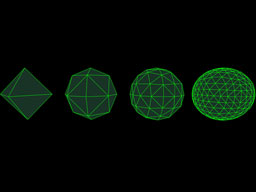More pages: 1
2
New demo
Saturday, February 28, 2009 | Permalink
It's been a while, but I have finally added another demo to my site. Yay!

Those of you wishing for some pretty eyecandy will be disappointed though. This demo features green spheres.

But it's pretty cool though if you're into shader programming. It shows how to emulate a stack and recursive functions in a shader in DX10.
Matt Enright
Saturday, February 28, 2009
Could this method be extended to GPU ray tracing? Current approaches often rely on multiple passes to emulate recursion for bounced rays, which requires an extra screen-sized buffer. That memory could be saved if a stack was available in the pixel shader.
Humus
Sunday, March 1, 2009
Sure. That's what I considered using it for first, but settled for something simpler just to get through the kinks of it.
ULJarad
Sunday, March 1, 2009
A demo that doesn't require 10.1, Hazah!
I have a few questions though. What are your thoughts on ray tracing and its future with multicore processors? Would you consider writing a demo of one?
Humus
Monday, March 2, 2009
You mean like on the CPU? I don't think CPUs ever will be fast enough to compete with GPUs. Ray tracing is certainly coming to the GPU though, but it'll still be a number of years before it gets close to mainstream. I don't think it will ever replace rasterization. Most likely you'll see people rasterize the primary rays and use ray tracing for secondary rays.
ULJarad
Monday, March 2, 2009
Do you still think that even with the introduction of multicore processors though? If both cpu and gpu performance double over two years (guestimation), I agree that the cpu would never overtake gpu, but do you not think doubling the number of cores every two years gives the cpu an advantage in the long run? Wouldn't it eventually lead to the cpu becoming powerful enough to rival the gpu as far as ray tracing is concerned?
I'd love to see a gpu vs cpu ray tracing demo.

Humus
Tuesday, March 3, 2009
GPU performance has been increasing much faster than CPU performance over the years, so the gap is actually increasing.
Matt Enright
Wednesday, March 4, 2009
GPUs will always lead CPUs for graphics simply because that's what they are designed to do - accelerate rendering. But it's interesting to see the roles change occasionally. Some developers have used PS3 Cells for post processing and the lighting pass of deferred shading, even though the GPU would do it faster. Those additional processors just don't have anything else to do and the video card already has it's work cut out for it.
GPU ray tracing is compelling largely because it opens up the possibilities of non-triangular world geometry. Isosurfaces, fractals, and voxels don't rasterize well. It also makes transparency and reflections very simple, which have plagued rasterization from day one.
ULJarad
Wednesday, March 4, 2009
Neat. I'll need to do some more reading.
So, what's the deal with processors then? Will their role continue to dwindle in and out of games?
More pages: 1
2



